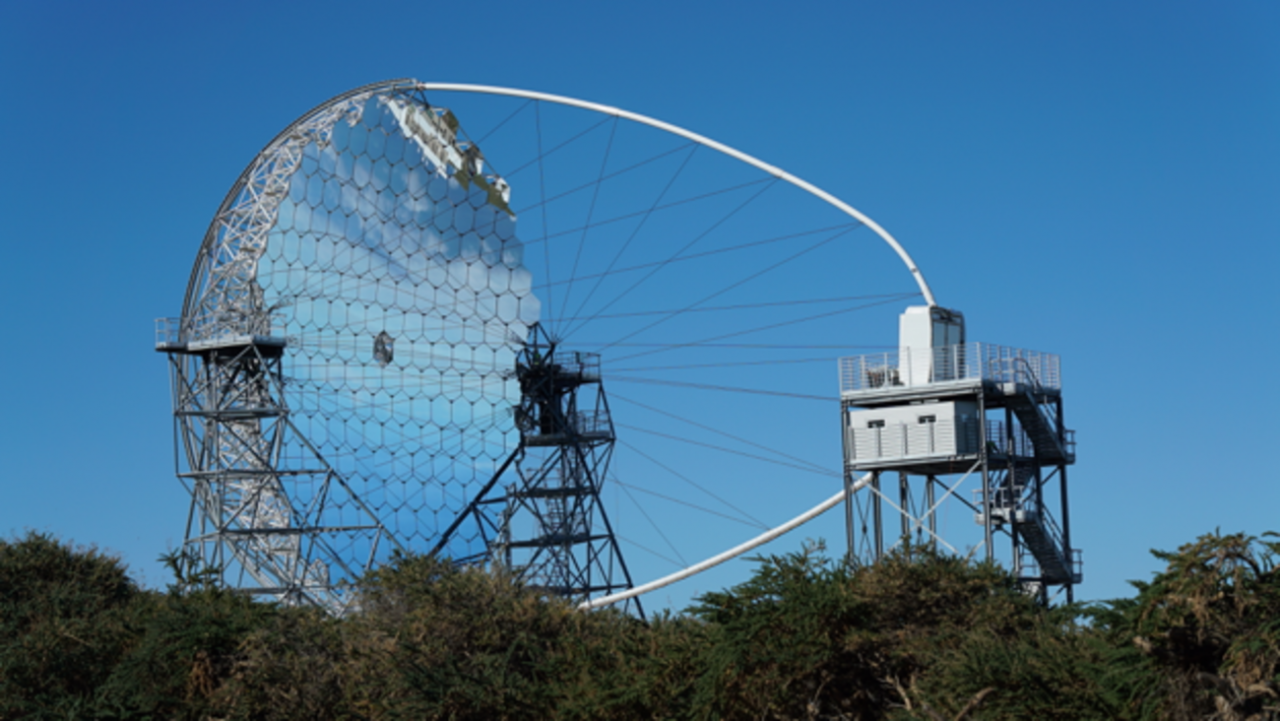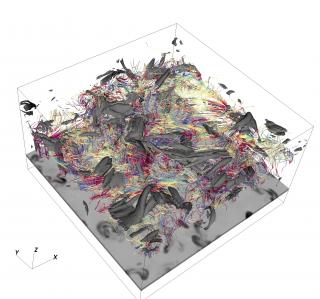Grants related:
General
The MAGIC Collaboration is integrated by 20 research institutes and university departments from Armenia, Bulgaria, Finland, Germany, Italy, Poland, Spain, Switzerland and USA. The collaboration comprises two 17m diameter telescopes, located at the Roque de los Muchachos Observatory, designed to measure the Cherenkov radiation associated with atmospheric showers from very high-energy gamma rays.
CTA is a major international collaboration for building two large Cherenkov observatories at North and South Hemispheres. Roque de los Muchachos Observatory in La Palma has been selected to host the Northern observatory. The first large size telescope was inaugurated in October 2018, and we are presently building the other three.
Members
Results
- Inauguration of the first large-size telescope of CTA (LST-1) at the Observatorio del Roque de Los Muchachos
- Detection of a neutrino generated in a blazar with MAGIC, IcCube and Fermi-LAT
- Discovery of the binary systemPSR J2032+4127/MT91 213 emitting in VHE gamma rays.
Scientific activity
Related publications
-
Rapid and multiband variability of the TeV bright active nucleus of the galaxy IC 310
Context. The radio galaxy IC 310 has recently been identified as a γ-ray emitter based on observations at GeV energies with Fermi-LAT and at very high energies (VHE, E > 100 GeV) with the MAGIC telescopes. Originally classified as a head-tail radio galaxy, the nature of this object is subject of controversy since its nucleus shows blazar-like
Aleksić, J. et al.Advertised on:
32014 -
Optimized dark matter searches in deep observations of Segue 1 with MAGIC
We present the results of stereoscopic observations of the satellite galaxy Segue 1 with the MAGIC Telescopes, carried out between 2011 and 2013. With almost 160 hours of good-quality data, this is the deepest observational campaign on any dwarf galaxy performed so far in the very high energy range of the electromagnetic spectrum. We search this
Puljak, I. et al.Advertised on:
22014 -
MAGIC upper limits on the GRB 090102 afterglow
Indications of a GeV component in the emission from gamma-ray bursts (GRBs) are known since the Energetic Gamma-Ray Experiment Telescope observations during the 1990s and they have been confirmed by the data of the Fermi satellite. These results have, however, shown that our understanding of GRB physics is still unsatisfactory. The new generation
García-López, R. J. et al.Advertised on:
22014 -
First Result from the Alpha Magnetic Spectrometer on the International Space Station: Precision Measurement of the Positron Fraction in Primary Cosmic Rays of 0.5–350 GeV
A precision measurement by the Alpha Magnetic Spectrometer on the International Space Station of the positron fraction in primary cosmic rays in the energy range from 0.5 to 350 GeV based on 6.8×106 positron and electron events is presented. The very accurate data show that the positron fraction is steadily increasing from 10 to ˜250GeV, but, from
Aguilar, M. et al.Advertised on:
42013 -
Introducing the CTA concept
The Cherenkov Telescope Array (CTA) is a new observatory for very high-energy (VHE) gamma rays. CTA has ambitions science goals, for which it is necessary to achieve full-sky coverage, to improve the sensitivity by about an order of magnitude, to span about four decades of energy, from a few tens of GeV to above 100 TeV with enhanced angular and
Scapin, V. et al.Advertised on:
32013 -
Dark matter and fundamental physics with the Cherenkov Telescope Array
The Cherenkov Telescope Array (CTA) is a project for a next-generation observatory for very high energy (GeV-TeV) ground-based gamma-ray astronomy, currently in its design phase, and foreseen to be operative a few years from now. Several tens of telescopes of 2-3 different sizes, distributed over a large area, will allow for a sensitivity about a
CTA Consortium et al.Advertised on:
32013 -
Gamma-ray burst science in the era of the Cherenkov Telescope Array
We outline the science prospects for gamma-ray bursts (GRBs) with the Cherenkov Telescope Array (CTA), the next-generation ground-based gamma-ray observatory operating at energies above few tens of GeV. With its low energy threshold, large effective area and rapid slewing capabilities, CTA will be able to measure the spectra and variability of GRBs
CTA Consortium et al.Advertised on:
32013 -
Observations of the magnetars 4U 0142+61 and 1E 2259+586 with the MAGIC telescopes
Context. Magnetars are an extreme, highly magnetized class of isolated neutron stars whose large X-ray luminosity is believed to be driven by their high magnetic field. Aims: We study for the first time the possible very high energy γ-ray emission above 100 GeV from magnetars, observing the sources 4U 0142+61 and 1E 2259+586. Methods: We observed
Backes, M. et al.Advertised on:
12013 -
Search for Very High Energy Gamma-ray Emission from Pulsar-Pulsar Wind Nebula Systems with the MAGIC Telescope
The MAGIC collaboration has searched for high-energy gamma-ray emission of some of the most promising pulsar candidates above an energy threshold of 50 GeV, an energy not reachable up to now by other ground-based instruments. Neither pulsed nor steady gamma-ray emission has been observed at energies of 100 GeV from the classical radio pulsars PSR
Anderhub, H. et al.Advertised on:
22010 -
VHE γ-Ray Observation of the Crab Nebula and its Pulsar with the MAGIC Telescope
We report about very high energy (VHE) γ-ray observations of the Crab Nebula with the MAGIC telescope. The γ-ray flux from the nebula was measured between 60 GeV and 9 TeV. The energy spectrum can be described by a curved power law dF/dE=f0(E/300 GeV)[a+blog10(E/300GeV)] with a flux normalization f0 of (6.0+/-0.2stat)×10-10 cm-2 s-1 TeV-1, a=-2.31+
Albert, J. et al.Advertised on:
22008 -
Very-High-Energy gamma rays from a Distant Quasar: How Transparent Is the Universe?
The atmospheric Cherenkov gamma-ray telescope MAGIC, designed for a low-energy threshold, has detected very-high-energy gamma rays from a giant flare of the distant Quasi-Stellar Radio Source (in short: radio quasar) 3C 279, at a distance of more than 5 billion light-years (a redshift of 0.536). No quasar has been observed previously in very-high
MAGIC Collaboration et al.Advertised on:
62008 -
Very High Energy Gamma-Ray Observations of Strong Flaring Activity in M87 in 2008 February
M87 is the only known nonblazar radio galaxy to emit very high energy (VHE) gamma rays. During a monitoring program of M87, a rapid flare in VHE gamma-rays was detected by the MAGIC telescope in early 2008. The flux was found to be variable above 350 GeV on a timescale as short as 1 day at a significance level of 5.6 σ. The highest measured flux
Albert, J. et al.Advertised on:
92008 -
Upper Limit for γ-Ray Emission above 140 GeV from the Dwarf Spheroidal Galaxy Draco
The nearby dwarf spheroidal galaxy Draco, with its high mass to light ratio, is one of the most auspicious targets for indirect dark matter (DM) searches. Annihilation of hypothetical DM particles can result in high-energy γ-rays, e.g., from neutralino annihilation in the supersymmetric framework. A search for a possible DM signal originating from
Albert, J. et al.Advertised on:
52008 -
The June 2008 Flare of Markarian 421 from Optical to TeV Energies
We present optical, X-ray, high-energy (lap30 GeV) and very high energy (gap100 GeV; VHE) observations of the high-frequency peaked blazar Mrk 421 taken between 2008 May 24 and June 23. A high-energy γ-ray signal was detected by AGILE with √{TS}=4.5 between June 9 and 15, with F(E>100 MeV) = 42+14 -12 × 10-8 photons cm-2 s-1. This flaring state is
Donnarumma, I. et al.Advertised on:
12009 -
Systematic Search for VHE Gamma-Ray Emission from X-Ray-bright High-Frequency BL Lac Objects
All but three (M87, BL Lac, and 3C 279) extragalactic sources detected so far at very high energy γ-rays belong to the class of high-frequency-peaked BL Lac objects. This suggested to us a systematic scan of candidate sources with the MAGIC telescope, based on the Donato et al. compilation of X-ray blazars. The observations took place from 2004
Albert, J. et al.Advertised on:
72008 -
Simultaneous Multiwavelength Observations of the Blazar 1ES 1959+650 at a Low TeV Flux
We present the results from a multiwavelength campaign on the TeV blazar 1ES 1959+650, performed in 2006 May. Data from the optical, UV, soft- and hard-X-ray, and very high energy (VHE) gamma-ray (E>100 GeV) bands were obtained with the Suzaku and Swift satellites, the MAGIC telescope, and other ground-based facilities. The source spectral energy
Tagliaferri, G. et al.Advertised on:
62008 -
Probing quantum gravity using photons from a flare of the active galactic nucleus Markarian 501 observed by the MAGIC telescope
We analyze the timing of photons observed by the MAGIC telescope during a flare of the active galactic nucleus Mkn 501 for a possible correlation with energy, as suggested by some models of quantum gravity (QG), which predict a vacuum refractive index ≃1+E, n=1,2. Parametrizing the delay between γ-rays of different energies as Δt=±τE or Δt=±τE, we
MAGIC Collaboration et al.Advertised on:
102008 -
Multiwavelength (Radio, X-Ray, and γ-Ray) Observations of the γ-Ray Binary LS I +61 303
We present the results of the first multiwavelength observing campaign on the high-mass X-ray binary LS I +61 303, comprising observations at the TeV regime with the MAGIC telescope, along with X-ray observations with Chandra, and radio interferometric observations with the MERLIN, EVN, and VLBA arrays, in 2006 October and November. From our MERLIN
Albert, J. et al.Advertised on:
92008 -
MAGIC Observations of the Unidentified γ-Ray Source TeV J2032+4130
We observed the first known very high energy (VHE) γ-ray-emitting unidentified source, TeV J2032+4130, for 94 hr with the MAGIC telescope. The source was detected with a significance of 5.6 σ. The flux, position, and angular extension are compatible with the previous ones measured by the HEGRA telescope system 5 years ago. The integral flux amounts
Albert, J. et al.Advertised on:
32008 -
MAGIC observations of PG 1553+113 during a multiwavelength campaign in July 2006
The active galactic nucleus PG 1553+113 was observed by the MAGIC telescope in July 2006 during a multiwavelength campaign, in which telescopes in the optical, X-ray, and very high energies participated. Although the MAGIC data were affected by strong atmospheric absorption (calima), they were analyzed after applying a correction. In 8.5 h, a
Albert, J. et al.Advertised on:
12009



